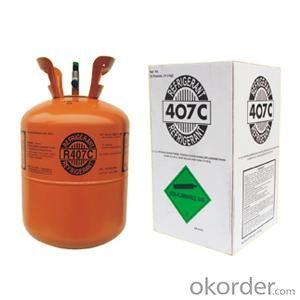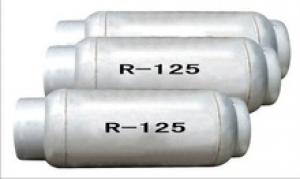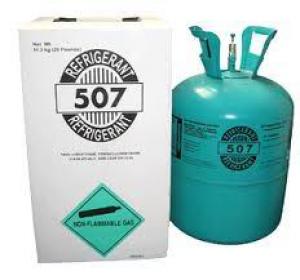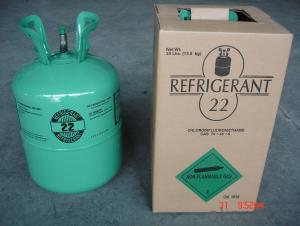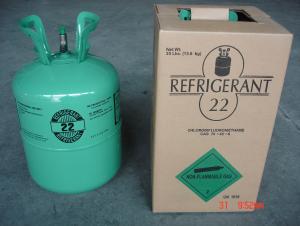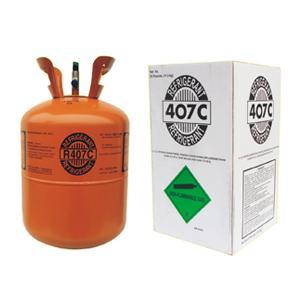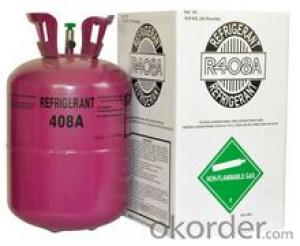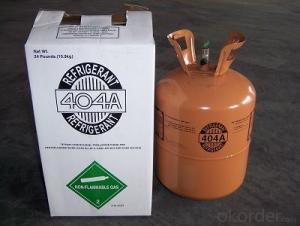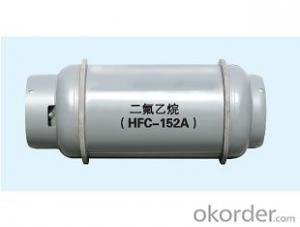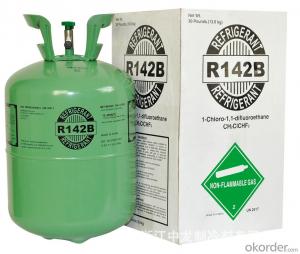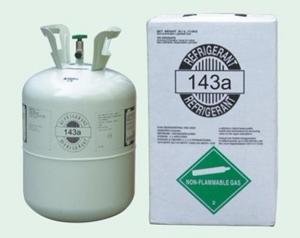Refrigerant Gas R407c
- Loading Port:
- Shanghai
- Payment Terms:
- TT OR LC
- Min Order Qty:
- -
- Supply Capability:
- 1000MT m.t./month
OKorder Service Pledge
OKorder Financial Service
You Might Also Like
Specifications
1.R407C
2.OEM is welcomed
3.Delivery within15 days
4.Disposable cylinder 11.3KG/ CYLINDER
Refrigerant R-407C is a kind of refrigerant of surrounds-protection model, used in replacing R22 R502. It has a good nature of cleaning, low poison, non-combustion, good-refrigeration and so on, and greatly used in air- conditioner.
Formula | CH2F2/CHF2CF3/CF3CH2F |
Boiling Point ( °C ) | -43.9 |
Vapor pressure(25°C),Mpa, abs | 1.174 |
Liquid density(25°C),kg/L | 1.136 |
Critical Pressure Mpa | 4.619 |
Critical temperature °C | 86.74 |
Gas heat capacity (1 atm, 25°C), kj/(kgk) | 0.829 |
Liquid heat capacity (1 atm, 25 °C),kg(kgk) | 1.54 |
Gas heat conductivity(25°C),w/(mk) | 0.01314 |
Liquid heat conductivity (25°C),w/(mk) | 0.0819 |
ODP | 0 |
GWP | 1.526 |
Odor | Odorless |
Color | Colorless, transparent |
HFC-32 %(W/W) | 23±2 |
HFC-125, %(W/W) | 25±2 |
Water, mg/kg ≤ | 10 |
Acidity, mg/kg ≤ | 1 |
Residue mg/kg ≤ | 100 |
Non-congealing gas-phase, % (v/v), ≤ | 1.5 |
- Q: What are the gaseous states of the oxygen-containing derivatives of the hydrocarbons under the standard conditions?
- Nitrogen derivatives are; dimethylamine;
- Q: High school chemical hydrocarbons with hydrocarbon derivatives with water solubility, density for accurate and comprehensive summary, thank you. Out of college entrance examination
- Hydrocarbons are insoluble in water and have a lower density than water
- Q: Will AsH3 (arsenic trioxide) is organic or inorganic
- AsH3 (arsine trihydride) is not containing C element
- Q: What are the inorganic compounds
- The precise organics are defined as: hydrocarbons and their derivatives. The derivative is the product of the hydrogen atom H being replaced by other radicals
- Q: Artemisinin is not a derivative of hydrocarbons
- A hydrocarbon is an organic compound (called a hydrocarbon) composed of two elements, carbon and hydrogen, and a hydrocarbon. Can be simply divided into open chain hydrocarbons, alicyclic hydrocarbons and aromatic hydrocarbons, all hydrocarbons are hydrophobic, that all the hydrocarbons are not soluble in water.
- Q: Cracked
- It is almost impossible for this problem to look at your reaction conditions. Generally speaking, the alkane reaction is mainly difficult to decompose directly into ions
- Q: Sodium can be used to identify derivatives of hydrocarbons
- The alcohol reacts with sodium. (Such as phenolic C6H5OH, cresol CH3C6H4OH, etc.), carboxylic acids (such as formic acid HCOOH, acetic acid CH3COOH, etc.) (description: hydroxyl groups in the carboxylic acid are hydroxyl groups in the carboxyl group) and hydroxyl groups containing polyhydroxyaldehydes and polyhydroxy ketones Such as glucose, fructose, etc.)
- Q: What are the characteristics of organic compounds?
- Organic compounds are usually referred to as carbon-containing compounds, or hydrocarbon-containing compounds and their derivatives are collectively referred to as organic matter. Organic compounds are generally insoluble in water and soluble in organic solvents with lower melting points. The vast majority of organic matter heat easily decomposed, easy to burn. The reaction of organic matter is generally slow and often accompanied by side effects, and there are many kinds of organic compounds, which can be divided into two major categories of hydrocarbon and hydrocarbon derivatives. According to the organic groups contained in the functional groups, divided into alkanes, alkenes, alkynes, aromatic hydrocarbons and alcohols, aldehydes, carboxylic acids, esters and so on. According to the organic carbon molecular structure, can also be divided into open chain compounds, carbocyclic compounds and heterocyclic compounds three categories.
- Q: From the molecular level, are not all the energy obtained from the redox reaction?
- You find the block out of the lithium battery thrown into the fire try ........ look at how the energy density
- Q: What is organic?
- Human beings have a long history of organic compounds. As early as the 17th century, humans could only obtain some organic compounds such as protein, fat, carbohydrate and dyes from animals and plants as food, food and clothing. 1828 German chemist Wilhelm (F Wohler) for the first time with inorganic acid ammonium nitrate synthesis of organic urea. After 1844, people have synthesized a large number of organic compounds such as methane, acetylene, acetic acid, oil and sugar, and since then humans have made organic chemistry into the synthetic era. The development of synthetic organic matter is clearly recognized: there is no clear boundary between organic matter and inorganic matter, but there are some differences in composition, structure and nature. Now people already know that organic compounds in the composition of most contain carbon, hydrogen, oxygen, nitrogen and other elements, a few also contain sulfur, phosphorus, halogen and so on. Any organic compound, its molecular composition contains carbon, the vast majority also contains hydrogen. Since the hydrogen atoms of the organic compound molecules can be replaced by other atoms or radicals, so many other organic compounds are derived, it is generally believed that hydrocarbons and their derivatives are known as organic compounds, referred to as organic compounds; The chemistry of compounds is called organic chemistry.
Send your message to us
Refrigerant Gas R407c
- Loading Port:
- Shanghai
- Payment Terms:
- TT OR LC
- Min Order Qty:
- -
- Supply Capability:
- 1000MT m.t./month
OKorder Service Pledge
OKorder Financial Service
Similar products
Hot products
Hot Searches
